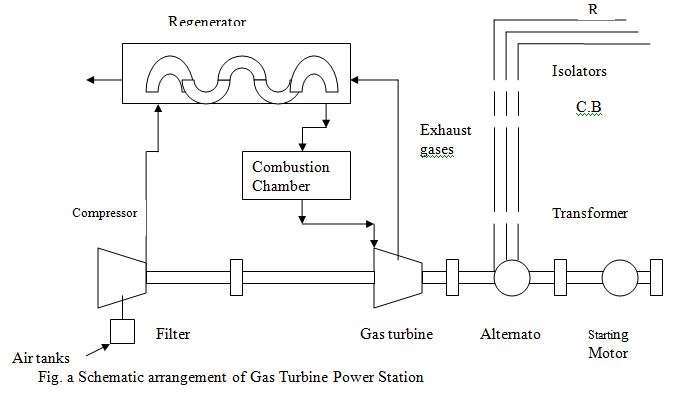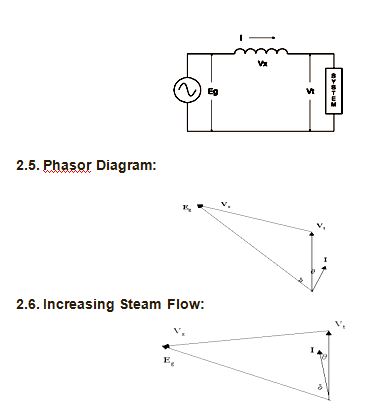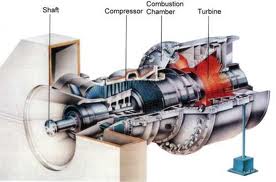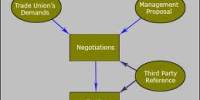1. Introduction:
In a gas turbine power plant the air is compressed by compressor and is led to the combustion chamber. In this chamber heat is added to the compressed air either by burning fuel in the chamber or by the use of air heaters and thus raising its temperature. The hot and high pressure air then passed to the gas turbine where it expands and converts to mechanical energy. The gas turbine drives the alternator which converts mechanical energy into electrical energy.
1.1 Background

Step up transformer is used for step up the generation voltage to transmission voltage. At the transmission substation the voltage is stepped down to medium voltage. The feeders carry power to the distribution substations. At the distribution sub-station the voltage is to step down to low distribution voltage. Distributors are used to supply power to the consumers.
2. Body
2.1. Gas Turbine Power Station
Gas turbine power plant has relatively low cast and can be quickly put into commision.it requires less space. This plant is of smaller capacity and mainly used for peak load service. Gas turbine power plants are very promising for region where liquid or gaseous fuel is available in large quantities. Gas turbine installations require only a fraction of water used by their steam turbine counterparts. Gas turbine has made rapid progress during the past decade due mainly to the large amount of research. The size of gas turbine plants used in a large size used is about 50 MW. the thermal efficiency of gas turbine plant is about 22% to 25%.
2.2. Schematic arrangement of Gas Turbine Power Station
The schematic arrangement (Fig. a) of a gas turbine power station can be divided into the following stages:
- Compressor
- Regenerator
- Combustion chamber
- Gas turbine
- Alternator
- Starting motor
- Electrical equipment

2.3. Characteristics of Gas Turbine Power Plants
Thermal efficiency of a gas turbine power plant varies with the effect of the temperature. With the addition of regeneration, inter-cooler and reheating the efficiency is raised. The approximate thermal efficiency for gas turbine stations on the assumption of atmospheric temperature of 15oC are as follows:
- a. Up to 7.5 MW uncompounded plant without regeneration 15 to 20% and with regeneration 20 to 25%.
- b. From 10 to 30 MW compound plant with regeneration 28 to 32%.
A 5oC change in inlet air temperature varies efficiency by about 3% and output by about 4% in open cycle plant.
2.4. Generator Simplified Equivalent Circuit:

3. Economics
Gas turbine power plants are particularly useful and economical where liquid or gaseous fuel is available in large/ quantities and the cost of gas is not excessive. Cost of a gas turbine power plant can be divided as following.
- Capital cost. Overall initial cost of a gas turbine power plant is relatively low as compared to steam power plant of equal size.
- Fixed cost. A gas turbine power plant has lower fixed charges than that of a gas power plant of same size.
- Running cost. Natural gas is used in a gas turbine power plant which is very cheap and due to high reliability and flexibility in operation; control of a gas turbine plant is very simple and easy.
4. Priority
4.1. Advantages of gas turbine engines
- Very high power-to-weight ratio, compared to reciprocating engines (ie. most road vehicle engines);
- Smaller than most reciprocating engines of the same power rating;
- Moves in one direction only, with far less vibration than a reciprocating engine, so very reliable;
- Simpler design.
- Low operating pressures.
- High operation speeds.
- Low lubricating oil cost and consumption.
4.2. Disadvantages of gas turbine engines
- Cost is much greater than for a similar-sized reciprocating engine (very high-performance, strong, heat-resistant materials needed);
- Use more fuel when idling compared to reciprocating engines – not so good unless in continual operation.
5. Summary
A gas turbine extracts energy from a flow of hot gas produced by combustion of gas or fuel oil in a stream of compressed air. It has an upstream air compressor (radial or axial flow) mechanically coupled to a downstream turbine and a combustion chamber in between. “Gas turbine” may also refer to just the turbine element.Energy is released when compressed air is mixed with fuel and ignited in the combustor. The resulting gases are directed over the turbine’s blades, spinning the turbine, and mechanically powering the compressor. Finally, the gases are passed through a nozzle, generating additional thrust by accelerating the hot exhaust gases by expansion back to atmospheric pressure.Energy is extracted in the form of shaft power, compressed air and thrust, in any combination, and used to power aircraft, trains, ships, electrical generators, and even tanks.
6. Recommendation
This gas turbine power plant station is simple and requires fewer auxiliaries and their control is easy. This power station size weighted as compared to an equivalent steam power plant. This power plant size and weighted are the main consideration such as ships, aircraft and locomotives, a gas turbine is more than that of a diesel engine plant. It’s initial and operating costs are much lower than that of equivalent steam power plant.
















